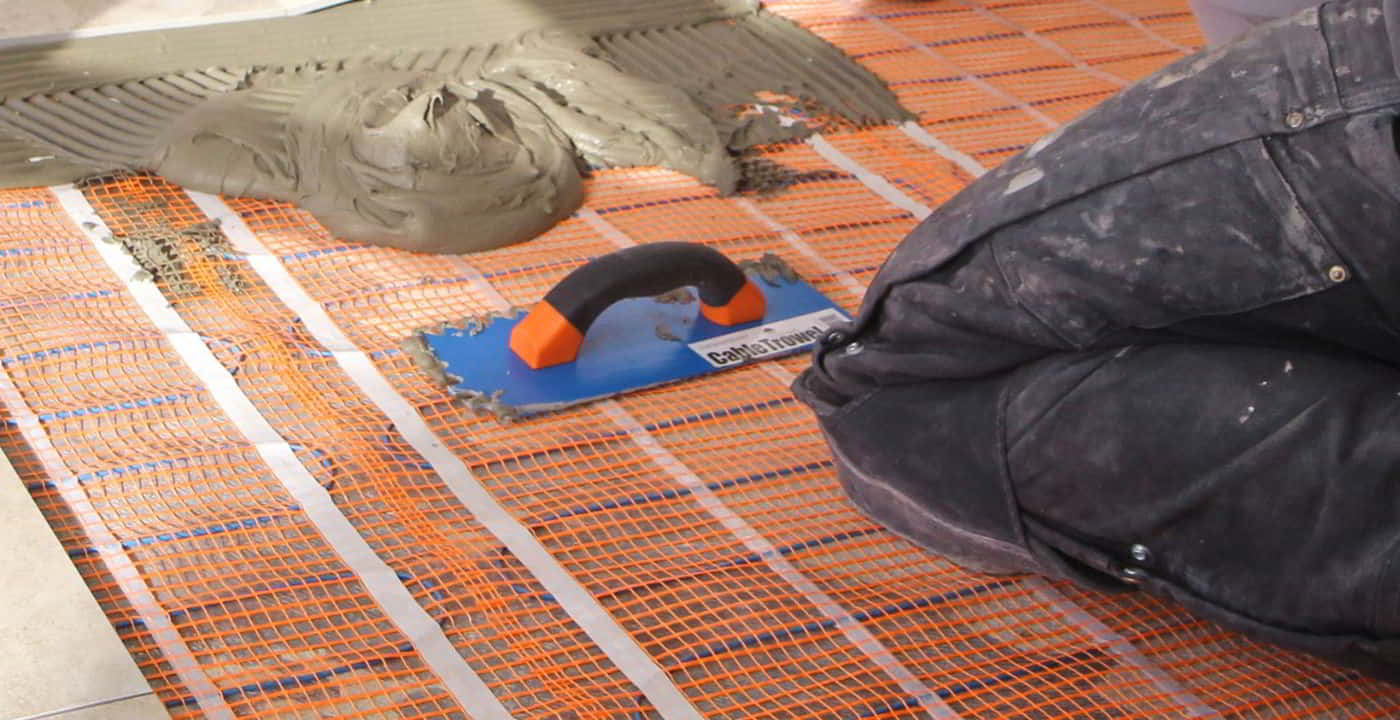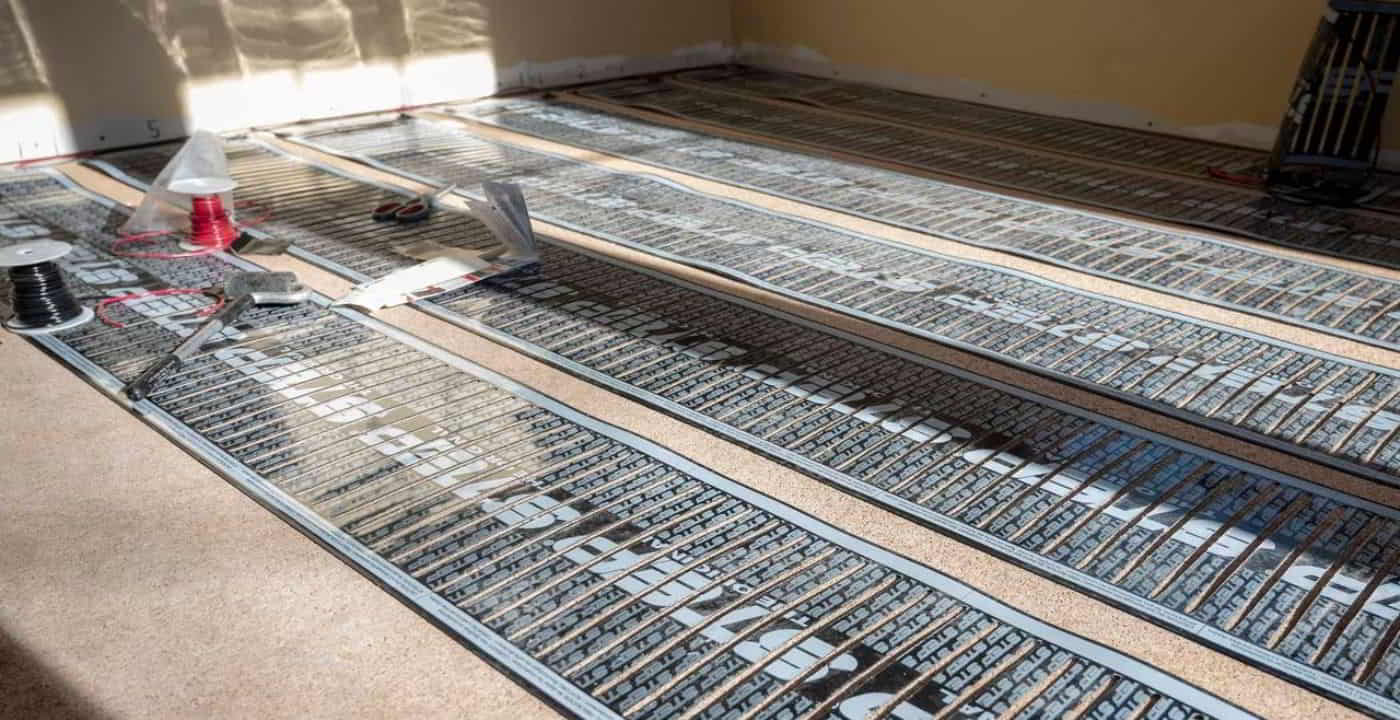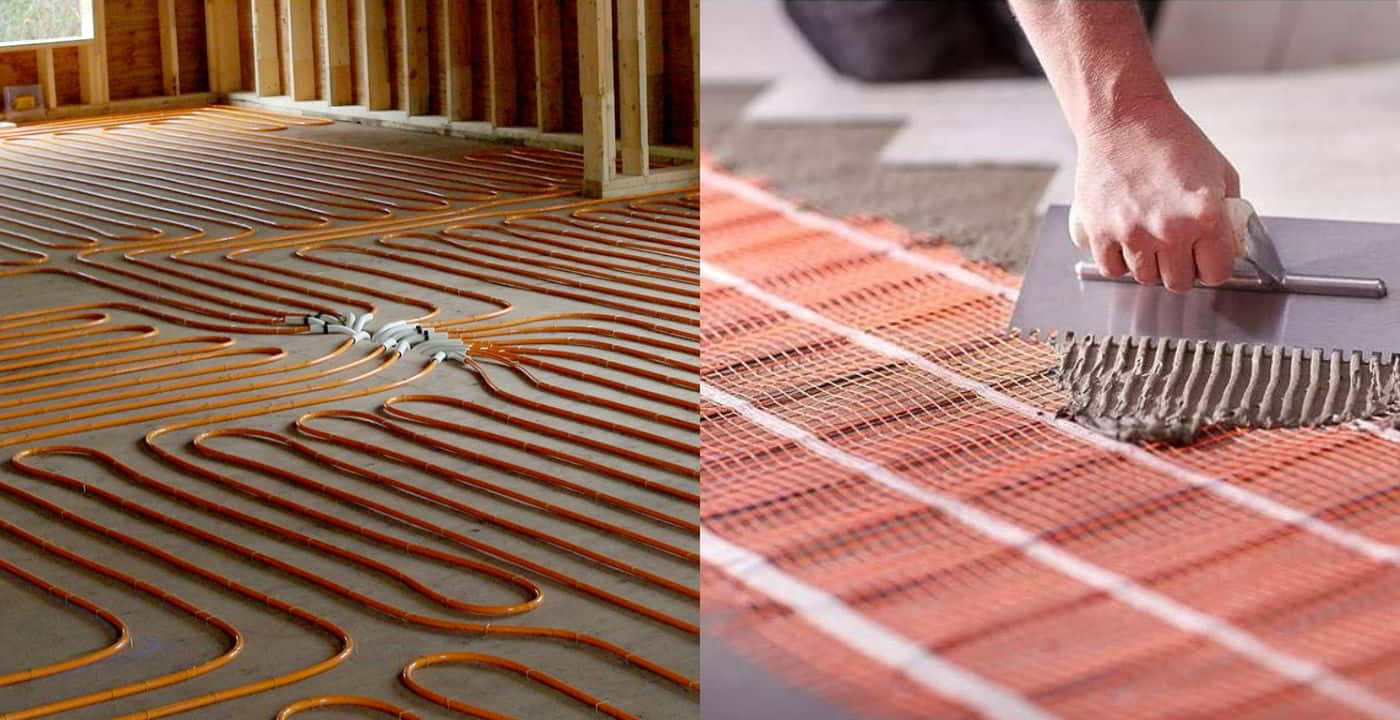Key Takeaways
- Radiant floor heating is an energy-efficient system ideal for new constructions.
- The integration of radiant heating in new builds offers long-term savings potential and health benefits.
- Compared to traditional heating systems, radiant floor heating provides uniform warmth, reducing drafts and cold spots in homes.
Follow the link to find out more about how much radiant floor heating costs – our in depth look into current prices.
What is radiant heat floor heating?
Unlike traditional furnace or forced air systems that heat the air, radiant heating focuses on heating the surfaces and objects in a room.
This methodology ensures an even distribution of warmth, resulting in a more consistent temperature throughout a space.
The direct contact of heat with the floor material creates an environment where cold spots are virtually non-existent, and warmth is felt the moment the system activates.
Check out our article for a closer inspection of radiant floor heating vs forced air.
What are the benefits of radiant floor heating?

Radiant floor heating offers numerous advantages for new home heating systems:
- Improved Energy Efficiency: Radiant heating can cut energy consumption by 20 to 40 percent, translating to reduced monthly bills. The system eliminates the inefficiencies found in ductwork, ensuring minimal heat loss.
- Lower Operating Costs: While the initial installation can be an investment, the monthly savings can be substantial, with some homeowners recouping their costs within a few years.
- Minimal Maintenance: Without the need for filters or duct maintenance, homeowners save on regular servicing costs.
- Health Benefits: Radiant systems do not circulate air, ensuring that dust, germs, and allergens remain undisturbed. This can lead to a healthier living environment, especially beneficial for those with asthma or bronchial conditions.
- Environmental Advantages: Particularly with hydronic systems, the possibility of using renewable energy sources like solar power makes radiant floor heating an eco-friendly option.
- Compatibility with Heat Pumps: Homes utilizing heat pumps will find radiant floor heating especially beneficial. The consistent warmth from the floor complements the efficiency of the pump, ensuring optimal heating at a lower cost.
Why is radiant floor heating better for new build homes?
Incorporating radiant floor heating during the construction phase of a new home is both practical and cost-effective.
Retro-fitting underfloor heating in existing properties can be a challenge, often requiring extensive floor modifications.
For new constructions, the process is streamlined, ensuring seamless integration without disruptions.
| Aspect | New Construction (Radiant Floor Heating) | Retrofitting (Radiant Floor Heating) |
|---|---|---|
| Installation Complexity | Simplified | Complex, often involving structural modifications |
| Cost Estimate | $6-$15 per sq.ft. | $8-$20 per sq.ft. (due to additional labor and material needs) |
| Construction Time | Typically 2-4 days (depends on property size) | 4-7 days (additional time due to potential structural adjustments) |
| Maintenance Needs | Minimal (annual checks recommended) | Minimal (but older homes might require more frequent checks) |
| Energy Efficiency | High (direct warmth ensures minimal heat loss) | High (same efficiency, but older home insulation can affect results) |
| Lifespan | Electric: ~30 years, Hydronic: ~25+ years | Slightly reduced due to potential incompatibility with older constructions |
| Integration with Other Systems | Easily integrated with home automation and modern HVAC | Might require more coordination with existing systems |
Radiant floor heating for commercial new build properties?
Commercial spaces, with their larger square footage, can greatly benefit from radiant heating.
Uniform temperature distribution, especially in open-concept areas, can lead to energy savings and enhance occupant comfort.
In offices, warehouses, or retail spaces, radiant floor heating promotes a better working environment while also showcasing an organization’s commitment to sustainable practices.
The different type of radiant floor heating for new constructions
In the realm of home heating solutions, radiant floor heating stands out as an innovative and highly efficient system, tailor-made for new constructions.
But like any forward-thinking technology, it isn’t a one-size-fits-all solution. Depending on your new home’s design, budgetary constraints, and specific needs, there’s a type of radiant floor heating that’s just right for you.
In this section, we’ll examine the nuances of these systems, highlighting their unique features, advantages, and drawbacks for new home installations.
Electric Radiant Floor Heating Systems

Electric radiant floor heating, often referred to as a ‘dry system’, is renowned for its simplicity and efficiency. It operates through a network of electric heating mats (or cables), installed directly below the floor surface, ensuring a uniformly warm floor.
The mats are strategically designed to offer even heating across the floor. When powered by your home’s electricity, these floor mats promptly heat up, providing direct warmth to the floor above.
Heated floor mats provide the advantage of localized control. Rather than depending on a central heating source, users can regulate the temperature of individual rooms or areas, optimizing energy usage while maintaining comfort.
While traditionally heated floor mats were most favored for specific rooms, like bathrooms or kitchens, recent technological advancements now allow homeowners to consider heating their entire home with these radiant floor mat systems.
Installation
The installation of an electric radiant floor heating system in a new construction is relatively straightforward, especially when compared to its hydronic counterpart or retro-fitting projects. Here are the key steps involved:
- Floor Preparation: Begin by ensuring the subfloor is devoid of any debris. It should be clean, dry, and smooth. Remove any protrusions, like nails or staples, to prevent potential damage to the mats.
- Layout Planning: Draft a plan to lay out the mats. Avoid placing mats under permanent fixtures, such as cabinets, to ensure heat is evenly distributed in the desired areas.
- Positioning the Heated Mats: Unroll or position the mats according to the pre-planned layout. Ensure they fit well and cover the desired areas.
- Embedding the Mats: Secure the mats in place using a thin-set mortar or self-leveling compound. This layer ensures the mats have optimal contact with the floor, facilitating efficient heat transfer.
- Electrical Connections: Have a licensed electrician connect the mats to your home’s electrical system. This ensures safety, proper grounding, and the installation of a dedicated circuit for the mats.
- Thermostat Installation: Finally, a digital thermostat is installed to allow homeowners to regulate the system’s temperature and schedule heating cycles.
Pros and Cons
Pros:
- Easy Installation: Typically simpler and quicker to install than hydronic systems, especially in retrofits.
- Low Maintenance: Once installed, these systems require minimal upkeep with no need for pumps or boilers.
- Quick Response Time: The electric systems heat up rapidly, providing warmth in a shorter time span.
Cons:
- Higher Operating Costs: Electricity costs can be higher than gas, leading to increased monthly bills if used extensively.
- Less Suitable for Large Areas: Due to higher operational costs, these systems are often recommended for smaller spaces or rooms.
- Floor Height Concerns: Installation can raise the level of the floor, potentially causing issues with door clearances and transitions to other rooms.
Impact of Flooring Types on Electric Radiant Floor Heating Installation
The type of flooring chosen plays a pivotal role in how an electric radiant floor heating system, especially heated floor mats, is installed and performs.
Each flooring material has unique properties that influence heat transfer and installation techniques.
Hardwood & Engineered Wood
Hardwood is a natural insulator, meaning it doesn’t conduct heat as effectively as tile.
However, it can still comfortably accommodate radiant heat, especially with engineered wood varieties.
When installing radiant heated mats under hardwood floors:
- Ensure proper subfloor preparation, ensuring it’s free from moisture.
- Use a thin-set layer or recommended adhesive to position the mats.
- Take care not to exceed the manufacturer-recommended temperature; excessive heat can damage or warp the wood.
Tile & Stone
Tile and stone are among the most thermally conductive flooring materials. This makes them ideal candidates for radiant heating systems.
When installing electric radiant heating under tile and stone:
- A layer of thin-set adhesive is essential for embedding the heating mats.
- The dense nature of tiles and stone ensures efficient heat transfer, warming up the floor quickly.
Laminate & Vinyl
Most modern laminate and vinyl flooring options have been designed to be compatible with radiant heating systems, so you needn’t worry about any issues with overheating.
When installing heated mats:
- A layer of thin-set adhesive is essential for embedding the heating mats.
- The dense nature of tiles and stone ensures efficient heat transfer, warming up the floor quickly.
Carpet
Carpet acts as an insulator, which can hinder the efficiency of radiant floor heating. However, with the right installation technique, it can work just as effectively as with any other type of floor.
When installing heated mats:
- Opt for a thin carpet and padding to ensure optimal heat transfer.
- Heated mats should be fully embedded in a self-leveling compound to ensure even heat distribution.
Concrete
Concrete floors can directly embed heating mats, making them highly efficient in terms of heat retention and distribution.
When installing electric radiant heated mats under concrete:
- During installation, the mats can be positioned within the concrete as it’s laid.
- Concrete’s thermal mass retains heat for extended periods, making it energy efficient.
- Add insulation to maximize energy efficiency and cost savings.
Estimated Costs ($)
Hydronic Radiant Floor Heating Systems

Hydronic radiant floor heating is considered the most popular and cost-effective among radiant heating solutions, especially for larger areas or new build properties.
Commonly termed a ‘wet system’, it functions using a series of flexible polyethylene tubes that run beneath the flooring. These tubes circulate warm water, which is heated by a furnace, thus radiating heat upwards.
The real beauty of the hydronic system lies in its adaptability. It can be paired with various heat sources, from conventional gas or oil boilers to more sustainable alternatives like solar water heaters or geothermal systems.
This adaptability not only ensures consistent warmth but also offers homeowners the flexibility to switch energy sources without overhauling the entire system. Plus, with its capability to maintain heat for longer durations, it operates in shorter cycles compared to its electric counterpart, leading to potential energy savings.
This makes it particularly suitable for new constructions that plan to incorporate multiple, complimentary heating solutions.
Installation
Hydronic systems are more involved in their installation due to the plumbing intricacies:
- Subfloor Preparation: A clean, flat surface is vital to ensure the proper layout of the tubing and prevent any damage or leaks.
- Mapping the Tubing Route: Before the installation, a detailed plan is drawn up, accounting for the tubing’s circuitous pattern and ensuring even heat distribution.
- Installing the Tubes: The flexible polyethylene tubes are carefully laid out on the subfloor according to the plan, often secured using staples or ties.
- Manifold Connection: Once the tubes are in place, they’re connected to a central manifold, which acts as the control center, distributing hot water from the boiler to the various tubes and returning cooled water back to the heating source.
- Laying the Floor: Over the tubes, a layer of screed or concrete is poured, which not only secures the tubes in place but also aids in the even distribution of heat.
- Boiler and Pump Connection: The system’s heart is the boiler, which heats the water. This is connected to the manifold, and a pump is installed to ensure the continuous circulation of water.
Pros and Cons
Pros:
- Cost-Effective for Large Spaces: Lower operational costs make them ideal for heating larger homes or spaces.
- Even, Consistent Heat: Delivers a uniform heat across the floor, enhancing overall comfort.
- Long Lifespan: With proper maintenance, the tubes and system can last several decades.
Cons:
- Complex Installation: Requires intricate plumbing and, potentially, structural alterations, especially in retrofits.
- Requires Boiler and Pump: Additional equipment, such as a boiler and circulation pump, is needed, which can demand maintenance.
- Slower Response Time: Takes longer to heat up compared to electric systems.
Estimated Costs ($)
Generally between $6 – $20 per sq foot
Hybrid Radiant Floor Heating Systems
Marrying the best of both worlds, the hybrid radiant floor heating system capitalizes on the strengths of both electric and hydronic systems.
Essentially, this system employs electric heating for smaller, standalone spaces like bathrooms, while relying on the hydronic approach for larger areas or where continuous heating is a necessity.
What makes the hybrid system particularly attractive is its adaptability. Homeowners can prioritize their heating needs based on the frequency of room usage and size. For instance, while a bathroom might benefit from the quick warmth provided by the electric system, living spaces or bedrooms might require the sustained, gentle heat of the hydronic system.
This dual approach doesn’t just ensure optimal comfort but also makes energy consumption more efficient. That being said, a hybrid system will make a new construction project more complex, adding additional time and expense.
Installation
Given that the hybrid system is a combination of the two aforementioned systems, the installation process is essentially a fusion of the steps detailed above.
- Determine Zones: Start by demarcating which areas will utilize electric heating and which will deploy hydronic heating.
- Follow Respective Installation Steps: For the electric zones, adhere to the electric system’s installation steps. Similarly, for the hydronic zones, the installation steps for the hydronic system should be followed.
- Unified Control System: Given that this is a hybrid system, it’s beneficial to have a unified control system or thermostat that can regulate both electric and hydronic systems, ensuring that the temperature remains consistent throughout the property.
Pros and Cons
Pros:
- Flexibility: Combines the best of both electric and hydronic systems, allowing for customized heating solutions.
- Adaptable Costs: Can optimize the operational cost by using electric heating in smaller zones and hydronic in larger areas.
- Efficient Energy Use: Can be paired with renewable energy sources, like solar panels, for more eco-friendly heating.
Cons:
- Complex Control Systems: Requires sophisticated control mechanisms to manage both systems seamlessly.
- Higher Initial Costs: The integration of both systems can elevate the upfront installation cost.
- Maintenance Variances: Different parts of the system (electric and hydronic) might have differing maintenance needs and schedules.
Estimated Costs ($)
Prices can range from $10 to $18 per sq.ft., depending on the configuration.
FAQs
Why is radiant floor heating more energy-efficient?
Unlike traditional systems that heat the air and circulate it, radiant systems directly heat surfaces and objects in a room, minimizing heat loss and delivering consistent warmth.
Can radiant floor heating be the sole heating source in a home?
Yes, particularly in well-insulated homes, radiant floor heating can serve as the primary heating source.
However, in extremely cold climates or large homes, a secondary source might be recommended.
How long do radiant floor heating systems typically last?
With proper installation and maintenance, hydronic systems can last up to 25 years or more, while electric systems have a lifespan of around 30 years.
Conclusion
For future-focused homeowners and builders eyeing the best new house heating systems, radiant floor heating presents a solution that marries efficiency, comfort, and sustainability.
With the ability to seamlessly integrate into new builds, it’s a choice that promises long-term returns, both in comfort and cost savings.
If you are looking to install radiant floor heating in a new construction take a look at our radiant floor mat heating kits, suitable for any kind of floor from wood to concrete, vinyl and more.





